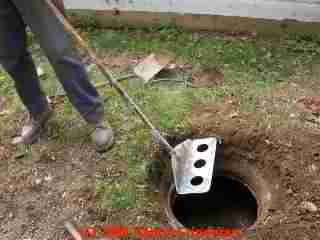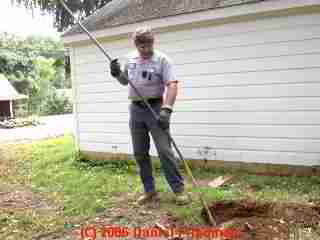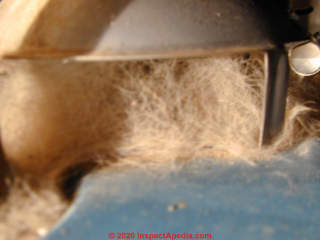 Actually Pumping out the Septic Tank
Actually Pumping out the Septic Tank
Step by step procedure
- POST a QUESTION or COMMENT about the steps and procedures in pumping out and cleaning a septic tank
How to pump out or clean a septic tank: details.
This septic tank pumpout article series provides a step by step, photo-illustrated guide to opening, pumping, and inspecting septic tanks, how a conventional septic tank is located, opened, pumped out, cleaned, and inspected.
This guideline is intended for septic pumping tank truck operators and as general information for homeowners or septic service companies concerned with septic system care.
The steps in servicing a septic tank are listed below, accompanied by photographs that show each of the critical steps in pumping, cleaning, and inspecting a septic tank.
InspectAPedia tolerates no conflicts of interest. We have no relationship with advertisers, products, or services discussed at this website.
- Daniel Friedman, Publisher/Editor/Author - See WHO ARE WE?
Pumping Out the Septic Tank - how the solids & waste are removed from a septic tank
In thi sarticle series we discuss all of the steps in proper septic tank maintenance:
- How the pumper truck or vacuum truck is operated.
- Tank inspection before pumping;
- Actually pumping out the septic tank;
- Inspections while pumping.
- Washing the septic tank after pumping,
- Inspecting the tank after pumping.
- Closing the septic tank
- Recording the septic tank location,
- Advising homeowners
The operator may use a muck-rake (shown here), an instrument resembling a long hoe, to stir sludge on the tank bottom during pumping to aid in sludge removal. The operator uses the muck raking tool to break up both the floating scum layer and settled sludge layer in the septic tank.
A few minutes are spent with this tool before pumping begins. During pumping the operator continues to use this tool to break up and pump out the floating scum layer in the septic tank.
Also see SEPTIC TANK PUMPING FREQUENCY GUIDE for a table explaining when to schedule a septic cleanout.

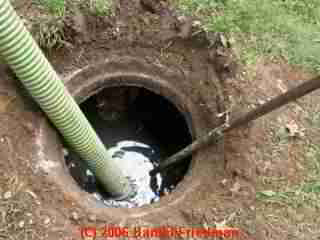
With the vacuum lines all connected, the pumper truck's vacuum pump operating, and the muck rake inserted into the septic tank, tank cleanout can begin.
The operator moves both the vacuum line and the muck rake continuously during the pumping operation, to break up scum and sludge, to mix these materials with effluent in the tank, and thus to remove them with the vacuum hose.
The breakup of sludge and scum and the mixing of them with tank effluent permits easy removal with the vacuum hose.
After removal of the scum layer and the first several inches of effluent, an astute septic pumper operator may pause the pumping operation and even shut off the pumper truck for a moment to listen.
If one hears septic effluent spilling back into the septic tank from the tank outlet line the operator has learned that the drain field is saturated, in failure, and is going to need replacement. This is valuable information which may otherwise be tough to obtain.
If the septic tank is plastic or fiberglass it may have a bottom or side plug.
The operator should be alert for possible accidental removal and loss of the tank plug during pumping as without the plug the tank will drain improperly into surrounding soil. Lost plugs will need replacement.

The photo shows a rectangle of floating scum layer material that has fallen from the septic tank inlet baffle area as the effluent level in the tank drops.
Septic service operators call this the "pillow" and its appearance is important. If this material is left in the tank baffles the system may become clogged.
Pumping continues to remove effluent and settled sludge.
Septic effluent is mixed with sludge on the tank bottom to aid in its removal.
...
Reader Comments, Questions & Answers About The Article Above
Below you will find questions and answers previously posted on this page at its page bottom reader comment box.
Reader Q&A - also see RECOMMENDED ARTICLES & FAQs
On 2020-07-29 by Dawn R
Horrors—our septic system backed up into two bathrooms last month. Apparently, the circuit breaker had tripped and the sump pump wasn’t working. Since it had been 5 years, called a local pumper to empty tank. To my surprise, they only opened the overflow tank and pumped that. I have never seen that before. We have always had the septic tank itself opened and pumped. I questioned the pumper and they said it was normal to pump the auxiliary/overflow tank. Is this true? Or did we get taken?
On 2020-06-03 - by (mod) -
Mark
Septic tank pumping/cleaning companies vary in how thorough and extensive a job they perform.
It's a better job if the tank inlet AND outlet baffle condition is inspected, and giving that second access point may make cleaning sludge and crud at that end easier to access.
On 2020-06-03 by Mark
Judging from from my neighbors' homes and the hand sketch left by the previous owner of my home, my septic tank has two "manholes" into it. I've dug and exposed one at the inlet end of the tank at a depth of about 13 inches. Is that sufficient to provide access for the service company to pump it, or do I need to locate and uncover other(s)? Thanks for any advice you can share!
On 2020-02-13 - by (mod) -
Craig,
Thanks for asking; the answer is ... it depends, on the specific pumper truck's pumping equipment, and both horizontal and vertical lift distances involved.
Please see https://inspectapedia.com/septic/Septic_Pumper_Truck_Vacuum_Pumps.php PUMPER TRUCK VACUUM PUMPS where we explain the limits of both horizontal distance and vertical lift for septic tank pumper trucks
There you'll find specific examples that answer your question
On 2020-02-13 by Craig Huff
How close does the truck need to get to the septic tank to pump it out?
Question: pumper said can't pump septic tank because of hair
Photo: Evidence that some buildings may indeed be exposed to large amounts of hair: thick clots of dog hair were drawn into this water heater draft hood, making the heater unsafe, risking carbon monoxide poisoning.
[Click to enlarge any image]
2020/05/24 hair in septic tank said:
I had a company come out to pump my septic tank. I do this every 3 years (1000 gallon tank) .
The operator told me he cannot pump it because I have an excessive amount of hair in the system .
He told me it would take 10 years to get this much hair in the system. He said he would talk to his boss but maybe a chemical treatment and retry in 3 months.
I did not agree to this treatment as I wanted research. I am glad I did because some of these treatments can be dangerous.
I was wondering if there was a work-around for this hair (ie: chopping it up then suction or using a larger pump tube size to extract).
Any advice is appreciated
Moderator reply: Problems Caused by Hair in the Septic Tank?
Bottom line: Normal volumes of hair may clog a drain but should not prevent pumping or cleaning a septic tank.
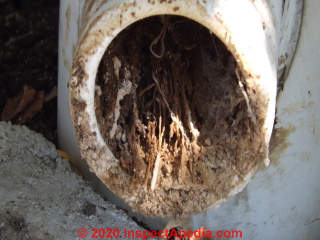 Finding so much hair in a septic tank that the tank can’t be pumped is unusual and needs some further investigation, confirmation that it’s actually hair, and some explanation are needed.
Finding so much hair in a septic tank that the tank can’t be pumped is unusual and needs some further investigation, confirmation that it’s actually hair, and some explanation are needed.
You may need a septic pumping contractor who has a decent grinder pump.
But first we need to understand that there really is a blocking material in your septic tank and if-so, how it got there and what it is.
Do not rely on a chemical treatment to “cure” a septic tank hair issue. Don’t even assume that it’s hair.
Is it possible that roots have gotten into your septic tank? Roots can look like hair, as you'll note in our photo of a root clogged sewer line in Greece.
Details: hair may clog traps and drains, but a clogged septic tanks such that it can't be pumped would be unusual.
I'm surprised by your report that there is so much hair in your septic tank that the tank can’t be cleaned.
Hair, whether from humans or pets, does not decompose in the the drain systm nor in the septic tank.
Normal volumes of hair entering the building drain/waste piping system from typical family washing and bathing does not normally cause trouble in the septic tank but might cause a clog at a sink, shower or bathtub drain or trap.
In contrast, large volumes of hair, such as might be produced in a beauty salon, barber shop, or pet washing business, can clog building drains and if entering the septic tank such hair might clog a septic tank inlet baffle, outlet baffle, or outlet filter. Large volumes of hair can also foul a septic pump or lift pump.
But having so much hair - if it really is hair - in a septic tank that the septic tank can't be pumped out is odd.
Having a so much hair in a septic tank that the tank cannot be pumped by the septic pumping truck would be a strange event and hard to explain.
In the septic tank hair will usually float and stick to the floating scum/grease layer in the tank, OR, less often, hair may settle to the tank bottom and join the settled solids there.
Septic pumper trucks can usually handle hair as well as floating scum and settled sludge
A typical septic tank pumper truck hose is 3 inches in diameter, and septic pumper trucks use powerful pumps that can even suck up small rocks as well as removing the floating scum layer and settled sludge layer in a septic tank.
In fact in writing the septic pump vacuum pump article I cite below, we did not find the word "hair" in septic pumper truck pump specifications or descriptions.
See details at PUMPER TRUCKS & VACUUM PUMPS SOURCES / SPECS
So I’m puzzled about why your septic tank could not be cleaned. Even a thick hardened floating scum or settled sludge layer can usually be pumped by the pumper.
She uses a long hoe-like device to break up the floating or settled waste so that it is mixed with the more-liquid waste in the tank so that, in turn, the sewage can be pumped out by the truck.
On occasion a pumper might actually add water to the septic tank to help break up solids for pumping.
Watch out: about a chemical treatment to try to dissolve hair, I agree with you that you want to hesitate about caustic chemical treatments, especially if the treatment is to be left for 3 months.
In my OPINION that suggestion might indicate that whoever is making it has an incomplete understanding of how septic systems work.
When someone dumps a chemical into the septic tank (usually ineffective and not needed) as soon as someone runs ANY plumbing fixture in the building, that chemical, diluted already by the septic tank liquid volume, is pushed out into the drainfield.
1. the treatment doesn't "stay" in the septic tank
2. the treatment may kill bacteria both in the tank and in the drainfield - leading to a drainfield failure as well as inability of the septic tank to treat pathogens in the sewage
Ask for an inspection of your septic tank by an experienced septic tank cleaning technician and let us know what you’re told.
See details about septic tank treatments
at SEPTIC TREATMENTS & CHEMICALS
...
Continue reading at INSPECT the SEPTIC TANK DURING PUMPING or select a topic from the closely-related articles below, or see the complete ARTICLE INDEX.
Or see these
Septic Tank Pumping Articles
- PUMPER TRUCKS & VACUUM PUMPS SOURCES / SPECS
- SEPTIC TANK, HOW TO FIND
- SEPTIC TANK LEVELS of SEWAGE
- SEPTIC TANK PUMPING MISTAKES
- SEPTIC TANK PUMPING PROCEDURE
- CLEANING SEPTIC TANKS
- WHEN to CLEAN THE SEPTIC TANK
- WHEN NOT TO PUMP A SEPTIC TANK
- FIND the SEPTIC TANK, HOW TO
- HOW TO OPEN a SEPTIC TANK
- INSPECT the SEPTIC TANK BEFORE PUMPING
- SEPTIC TANK INSPECTION PROCEDURE
- SEPTIC TANK LEVELS of SEWAGE
- PUMPER TRUCK OPERATION PROCEDURE
- PUMPING the SEPTIC TANK
- RECORD SEPTIC TANK LOCATION
- SEPTIC PUMPING CONCLUSIONS
- SEPTIC TANK PUMPING REASONS
- SEPTIC TANK PUMPING SCHEDULE
- SEPTIC TANK SAFETY
- SEPTIC TREATMENTS & CHEMICALS
Suggested citation for this web page
PUMPING the SEPTIC TANK at InspectApedia.com - online encyclopedia of building & environmental inspection, testing, diagnosis, repair, & problem prevention advice.
Or see this
INDEX to RELATED ARTICLES: ARTICLE INDEX to SEPTIC SYSTEMS
Or use the SEARCH BOX found below to Ask a Question or Search InspectApedia
Ask a Question or Search InspectApedia
Questions & answers or comments about the steps and procedures in pumping out and cleaning a septic tank
Try the search box just below, or if you prefer, post a question or comment in the Comments box below and we will respond promptly.
Search the InspectApedia website
Note: appearance of your Comment below may be delayed: if your comment contains an image, photograph, web link, or text that looks to the software as if it might be a web link, your posting will appear after it has been approved by a moderator. Apologies for the delay.
Only one image can be added per comment but you can post as many comments, and therefore images, as you like.
You will not receive a notification when a response to your question has been posted.
Please bookmark this page to make it easy for you to check back for our response.
IF above you see "Comment Form is loading comments..." then COMMENT BOX - countable.ca / bawkbox.com IS NOT WORKING.
In any case you are welcome to send an email directly to us at InspectApedia.com at editor@inspectApedia.com
We'll reply to you directly. Please help us help you by noting, in your email, the URL of the InspectApedia page where you wanted to comment.
Citations & References
In addition to any citations in the article above, a full list is available on request.
- New York State Department of Health, APPENDIX 75-A WASTEWATER TREATMENT STANDARDS - INDIVIDUAL HOUSEHOLD SYSTEMS , [PDF] New York State Department of Health, 3 February 2010, retrieved 3/1/2010, original source: https://www.health.ny.gov/regulations/nycrr/title_10/part_75/appendix_75-a.htm
- Special thanks to M & O Sanitation, Dutchess County NY (845) 471-0308 for permitting us to photograph steps during septic system service at our demonstration property.
- SEPTIC TANK CAPACITY VS USAGE in Daily Gallons of Wastewater Flow, calculating required septic tank size, calculating septic tank volume from size measurements
- SEPTIC TANK/SOIL-ABSORPTION SYSTEMS: HOW TO OPERATE & MAINTAIN [PDF] - , Equipment Tips, U.S. Department of Agriculture, 8271 1302, 7100 Engineering, 2300 Recreation, September 1982, web search 08/28/2010, original source: http://www.fs.fed.us/t-d/pubs/pdfimage/82711302.pdf.
- "International Private Sewage Disposal Code," 1995, BOCA-708-799-2300, ICBO-310-699-0541, SBCCI 205-591-1853, available from those code associations.
- "Manual of Policy, Procedures, and Guidelines for Onsite Sewage Systems," Ontario Reg. 374/81, Part VII of the Environmental Protection Act (Canada), ISBN 0-7743-7303-2, Ministry of the Environment,135 St. Clair Ave. West, Toronto Ontario M4V 1P5 Canada $24. CDN.
- Manual of Septic Tank Practice, US Public Health Service's 1959.
- Pennsylvania State Wastewater Treatment Fact Sheet SW-161, Septic System Failure: Diagnosis and Treatment
- Pennsylvania State Wastewater Treatment Fact Sheet SW-162, The Soil Media and the Percolation Test
- Pennsylvania State Wastewater Treatment Fact Sheet SW-l64, Mound Systems for Wastewater Treatment
- Pennsylvania State Wastewater Treatment Fact Sheet SW-165, Septic Tank-Soil Absorption Systems
- Document Sources used for this web page include but are not limited to: Agricultural Fact Sheet #SW-161 "Septic Tank Pumping," by Paul D. Robillard and Kelli S. Martin. Penn State College of Agriculture - Cooperative Extension, edited and annotated by Dan Friedman (Thanks: to Bob Mackey for proofreading the original source material.)
- Onsite Wastewater Disposal, R. J. Perkins; Quoting from Amazon: This practical book, co-published with the National Environmental Health Association, describes the step-by-step procedures needed to avoid common pitfalls in septic system technology. Valuable in matching the septic system to the site-specific conditions, this useful book will help you install a reliable system in both suitable and difficult environments. Septic tank installers, planners, state and local regulators, civil and sanitary engineers, consulting engineers, architects, homeowners, academics, and land developers will find this publication valuable.
- Onsite Wastewater Treatment Systems, Bennette D. Burks, Mary Margaret Minnis, Hogarth House 1994 - one of the best septic system books around, suffering a bit from small fonts and a weak index. While it contains some material more technical than needed by homeowners, Burks/Minnis book on onsite wastewater treatment systems a very useful reference for both property owners and septic system designers.
- Septic Tank/Soil-Absorption Systems: How to Operate & Maintain, Equipment Tips, U.S. Department of Agriculture, 8271 1302, 7100 Engineering, 2300 Recreation, September 1982, web search 08/28/2010, original source: http://www.fs.fed.us/t-d/pubs/pdfimage/82711302.pdf
- Septic System Owner's Manual, Lloyd Kahn, Blair Allen, Julie Jones, Shelter Publications, 2000 $14.95 U.S. - easy to understand, well illustrated, one of the best practical references around on septic design basics including some advanced systems; a little short on safety and maintenance. Both new and used (low priced copies are available, and we think the authors are working on an updated edition--DF. Quoting from one of several Amazon reviews: The basics of septic systems, from underground systems and failures to what the owner can do to promote and maintain a healthy system, is revealed in an excellent guide essential for any who reside on a septic system. Rural residents receive a primer on not only the basics; but how to conduct period inspections and what to do when things go wrong. History also figures into the fine coverage.
- Septic System Owner's Manual, Lloyd Kahn, Blair Allen, Julie Jones, Shelter Publications, 2000 $14.95 U.S. - easy to understand, well illustrated, one of the best practical references around on septic design basics including some advanced systems; a little short on safety and maintenance. Both new and used (low priced copies are available, and we think the authors are working on an updated edition--DF. Quoting from one of several Amazon reviews: The basics of septic systems, from underground systems and failures to what the owner can do to promote and maintain a healthy system, is revealed in an excellent guide essential for any who reside on a septic system. Rural residents receive a primer on not only the basics; but how to conduct period inspections and what to do when things go wrong. History also figures into the fine coverage.
- Grass is Always Greener Over the Septic Tank, Bombeck, Erma: $ 5.99; FAWCETT; MM; This septic system classic whose title helps avoid intimidating readers new to septic systems, is available new or used at very low prices. It's more entertainment than a serious "how to" book on septic systems design, maintenance, or repair. Not recommended -- DF.
- US EPA ONSITE WASTEWATER TREATMENT SYSTEMS MANUAL Top Reference: US EPA's Design Manual for Onsite Wastewater Treatment and Disposal, 1980, available from the US EPA, the US GPO Superintendent of Documents (Pueblo CO), and from the National Small Flows Clearinghouse. Original source http://www.epa.gov/ORD/NRMRL/Pubs/625R00008/625R00008.htm
- Water Wells and Septic Systems Handbook, R. Dodge Woodson. This book is in the upper price range, but is worth the cost for serious septic installers and designers.
Quoting Amazon: Each year, thousands upon thousands of Americans install water wells and septic systems on their properties. But with a maze of codes governing their use along with a host of design requirements that ensure their functionality where can someone turn for comprehensive, one-stop guidance? Enter the Water Wells and Septic Systems Handbook from McGraw-Hill.
Written in language any property owner can understand yet detailed enough for professionals and technical students this easy-to-use volume delivers the latest techniques and code requirements for designing, building, rehabilitating, and maintaining private water wells and septic systems. Bolstered by a wealth of informative charts, tables, and illustrations, this book delivers:
* Current construction, maintenance, and repair methods
* New International Private Sewage Disposal Code
* Up-to-date standards from the American Water Works Association - Wells and Septic System, Alth, Max and Charlet, Rev. by S. Blackwell Duncan, $ 18.95; Tab Books 1992. We have found this text very useful for conventional well and septic systems design and maintenance --DF. Quoting an Amazon description:Here's all the information you need to build a well or septic system yourself - and save a lot of time, money, and frustration. S. Blackwell Duncan has thoroughly revised and updated this second edition of Wells and Septic Systems to conform to current codes and requirements. He also has expanded this national bestseller to include new material on well and septic installation, water storage and distribution, water treatment, ecological considerations, and septic systems for problem building sites.
- Advanced Onsite Wastewater Systems Technologies, Anish R. Jantrania, Mark A. Gross. Anish Jantrania, Ph.D., P.E., M.B.A., is a Consulting Engineer, in Mechanicsville VA, 804-550-0389 (2006). Outstanding technical reference especially on alternative septic system design alternatives. Written for designers and engineers, this book is not at all easy going for homeowners but is a text I recommend for professionals--DF.
- US EPA ONSITE WASTEWATER TREATMENT SYSTEMS MANUAL [online copy, free] Top Reference: US EPA's Design Manual for Onsite Wastewater Treatment and Disposal, 1980, available from the US EPA, the US GPO Superintendent of Documents (Pueblo CO), and from the National Small Flows Clearinghouse. Original source http://www.epa.gov/ORD/NRMRL/Pubs/625R00008/625R00008.htm Onsite wastewater treatment and disposal systems, Richard J Otis, published by the US EPA. Although it's more than 20 years old, this book remains a useful reference for septic system designers. U.S. Environmental Protection Agency, Office of Water Program Operations; Office of Research and Development, Municipal Environmental Research Laboratory; (1980)
- The NSFC Products List has an excellent list of design manuals/modules National Small Flows Clearinghouse (NSFC) now (2019/12/13) hosted at http://www.nesc.wvu.edu/ Tel: 304-293-4191 e-mail info@mail.nesc.wvu.edu.
he National Small Flows Clearinghouse (NSFC) was funded by the U.S. Environmental Protection Agency (EPA) to help America's small communities and individuals solve their wastewater problems through objective information about onsite wastewater collection and treatment systems. NSFC products and information are the only national resource of its type, dealing with small community wastewater infrastructure. or by telephone 800-624-8301 - In addition to citations & references found in this article, see the research citations given at the end of the related articles found at our suggested
CONTINUE READING or RECOMMENDED ARTICLES.
- Carson, Dunlop & Associates Ltd., 120 Carlton Street Suite 407, Toronto ON M5A 4K2. Tel: (416) 964-9415 1-800-268-7070 Email: info@carsondunlop.com. Alan Carson is a past president of ASHI, the American Society of Home Inspectors.
Thanks to Alan Carson and Bob Dunlop, for permission for InspectAPedia to use text excerpts from The HOME REFERENCE BOOK - the Encyclopedia of Homes and to use illustrations from The ILLUSTRATED HOME .
Carson Dunlop Associates provides extensive home inspection education and report writing material. In gratitude we provide links to tsome Carson Dunlop Associates products and services.


